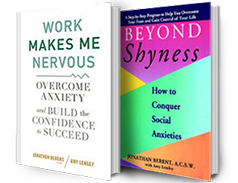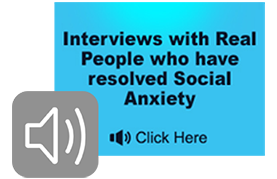M. is a 44-year-old “genius” with complex systems in Silicon Valley who recently graduated from his therapy with me for public speaking anxiety. In his final session he told me that one of the reasons for his success was the concept of “measurability” as he “has an engineering brain”. I decided to take this concept and apply it to my patients. As my practice has been 99% online during the last five years, I surveyed my patients from around the country during the last week. I asked them to measure their “concern” about the virus on a scale of 1-10. Here are some results.
B., age 21, a college sophomore in Georgia with pervasive social anxiety, A, age 15, an adolescent who has recovered from selective mutism, living near Houston, Texas, A, a 17-year-old female in Los Angeles, with pervasive social anxiety and avoidant personality, and J. a 30 year old lawyer in Manhattan with zero social life outside of his family, were not even able to give me numbers as all were relishing the idea of social isolation with no social stress.
As these individuals’ function at a relatively low level socially, despite their intellectual intelligence which is high, their responses did not surprise me given their relatively primitive attitude toward socializing.
S. is a 53-year-old CEO of a global company living in Long Island who is working on his performance anxiety. He said his concern is a “5” as his family is safe. In addition, he felt “excitement” regarding his management challenge, referencing back to 2008. Another public speaking patient is S who is a 45-year-old financial analyst. He also lives on Long Island. He has three young children. I must say his answer was “mind blowing” to me. His said “0; I’m confused. I don’t understand the big deal. It’s only a virus”. It’s certainly a good thing that his wife has a totally different attitude.
N. a 27-year-old with long term depression and anxiety living in Manhattan gave a “10”. He was “paralyzed”. He was concerned that people close to him could die. In addition, he recently started dating a young woman whom he was very serious about. The virus has put the situation on hold creating extreme frustration.
C. age 38, a scientist in North Carolina is working on her public speaking anxiety and erythrophobia (fear of blushing). She gave it an “8-9” as she lived with her older in laws. She was concerned about transmitting to them.
E. a 19-year-old living in Queens, New York is in the process of recovering from her chronic social anxiety and depression. Her parents are Libertarians. Their concern is a “1-2” as they believe “that the virus is a hoax facilitated by the media against Trump”. E. gives it a “9”. She is especially frustrated that she was resolving her school phobia and now the process is on hold.
J., a 45-year-old in Washington D.C., is another public speaking patient who works in a large corporation. He is in a very empowered state because he is now free from the public speaking anxiety that last year caused him to leave work abruptly. He was especially energized and empathic to “those who are suffering”; saying that he wants to influence his corporation to help those in need. His concern was a “9”.
It’s disturbingly ironic that having worked with social anxiety for over four decades I now have to encourage people to refine their social distancing skills.
Be Smart. Be Safe.
During my forty plus years of clinical experience with social anxiety I’ve worked directly with, and supervised treatment for, approximately ten thousand individuals between the ages of four and seventy from many cultures. The clinical spectrum has ranged from public speaking anxiety and erythrophobia to pervasive social avoidance and adult selective mutism. Functioning levels have ranged from C suite executives with seven figure salaries to adults who have isolated themselves in their homes for years. I’ve spent literally a few hundred thousand hours on the clinical front line. Treatment has included individual, family, group and special needs therapeutic communities. I’ve seen everything from a cure to the problem remaining permanent, and everything in between. Many of my patients who have done well in treatment have said about therapy “this is the hardest thing I’ve ever done”.
This is in direct contrast to the statements by the CBT community where positive results are promised within a short-term context of approximately 10-15 sessions. Now, something is very wrong here. While I believe that CBT can help many, it’s claims regarding social anxiety are grossly misleading and flawed. These claims are a significant component of the greater common misunderstanding of the disorder. CBT offers social anxiety sufferers the belief that the disorder can be resolved via behavioral and cognitive technique. This is simply not true. It puts the consumer at risk for unrealistic expectations regarding treatment. The reality is that while technique can help immensely with self-regulation; it does not touch the core emotionality that causes and drives the problem!
The reality is that social anxiety is an assault on personhood concurrent with nervous system overload. CBT claims make a mockery of this dynamic and the fact that social anxiety is the “quintessential disease of resistance”.
Having reached my breaking point with CBT claims I decided to channel the energy of my anger, which is a dynamic I try to teach my patients, into research which has never been done; researching the research on CBT and social anxiety. The following are my conclusions.
- None of the research identifies differences in the functioning levels of participants. There is no differentiation between subjects with and without initiative for treatment. There is minimal understanding of social anxiety as a spectrum disorder.
- There is little differentiation of social anxiety symptoms.
- The vast majority of research has taken place in university settings. This is going to limit greatly the type of profile of participants. This is putting it mildly.
- The statements regarding short term treatment success are in direct conflict with my clinical experience which leads me to conclude that inherent in this research is a basic misunderstanding of the core psycho-pathology at play.
Here is the research:
Social anxiety has been on the radar of doctors and clinicians since the 1970s when articles and studies first started to appear in trade publications. Scholarly attention on social anxiety disorder and its treatment began to increase steadily through the 1980s, the 1990s and into the 2000s. Conducting a PubMed search for articles with the search terms “cognitive behavioral therapy (CBT) for social anxiety disorder (SAD)” as an example, one can see a sharp rise in the number of sources since 2010 and especially in the five years between 2013 and 2018. The average number of articles is 153, as opposed to an average of 71 for the five years prior. Similarly, using the same search terms and selecting for clinical trial articles, there is a high number of articles between 2014 and 2018, with an average of 244 a year. This should indicate to even a lay reader that social anxiety disorder has captured the increased interest of psychiatrists and social scientists.
Social phobia, or, social anxiety disorder was not a clearly defined diagnostic category until the publication of the DSM-III in 1980 (APA, 1980). Psychiatric attention had mostly been given to generalized anxiety. By the 1990s it was clear that much more attention should and could be given to researching the pathophysiology of SAD (Rapee, Spence, 1994). It was thought that there exists within SAD a continuum, with shyness at one end of the continuum, social phobia or social anxiety in the middle, and avoidant personality at the other end. Scholars also believe that sometimes these terms might overlap depending on the external stressors or fears of negative evaluation (Rapee and Spence 1994; Holt, Heimberg, and Hope, 1992).
Reading the vast number of articles based on these search terms that were published in the past five years would be too much for the scope of this review — the intent of which is to summarize the main trends of efficacy of treating SAD with CBT. No other psychological treatments for SAD have been evaluated with the same scientific rigor as CBT has to date. Those treatments are mentioned here only for comparison.
General Overview of Articles on CBT
Among the PubMed articles reporting on the results of clinical trials with CBT, there are four general categories: CBT as sole therapy, CBT and pharmacologic intervention, CBT and co-morbidity, and CBT compared to other therapies. Trials were largely connected to clinical psychology or psychiatry departments at universities or colleges and followed the usual protocols one expects in research studies involving human subjects. One measurement tool that repeats in many of the studies is the QoLI, or Quality of Life Inventory. While SAD is acknowledged to be a severe and debilitating disorder affecting over 13% of the population (Kessler, Petukhova, Sampson, Zaslavsky, & Wittchen, 2012), its experience is largely subjective as are the changes felt from therapy, hence the development of the QoLI tool.
Cognitive behavioral therapy was initially called cognitive therapy by Aaron Beck in 1979. CBT is now an umbrella term that includes a range of techniques including behavioral strategies, cognitive restructuring, exposure therapy, social skills training, relaxation, and videotape feedback (Antony & Rowa, 2008). More recently, a third-wave CBT has developed, to include acceptance and commitment therapy (ACT) (Hayes, 2004), mindfulness based cognitive therapy (Teasdale, 2000), compassion focused training (Gilbert, 2005), and attentional training (Fisticki, Saatcioglu, et al 2015). Cognitive behavioral therapy generally involves between eight and sixteen weekly one-hour sessions in either individual or group formats (Anthony & Rowa, 2008).
CBT as “Gold Standard”
Many champions of CBT consider it the gold standard and the best form of psychotherapy currently available but they have been challenged by therapists who want more plurality. Proponents of CBT acknowledge that treatment methods can improve — after all, it’s only the gold standard because no other treatment model has been studied as much nor has one yielded such positive results for a wide range of disorders. However, many studies have been criticized to be of low quality or with weak comparisons. Perhaps future clinical studies that feature more stringent criteria, such as better and smaller sampling can show why CBT remains systematically superior. (David, D., Cristea, I., & Hofmann, S. G. 2018).
CBT did not form in a vacuum. It developed from many existing sources of therapies, such as such as interpersonal therapy (IPT), humanistic therapies, systemic therapy, and psychodynamic therapy (PDT). There never has nor will there ever be one therapy that fits all. Pluralism recognizes the widespread need for multiplicity of ideas and approaches in science in general, and in the field of psychotherapy in particular. To consider CBT a panacea is shortsighted, especially when analysis of CBT studies show them to be highly biased (by researchers). Studies also show that CBT is not actually superior to any other treatments. Additionally, there are few mechanisms within CBT itself that it is improving as a treatment option, and little within it to prove that long-term change in patients is possible (Leichsenrung, et al, 2018).
Despite criticisms, CBT is considered the gold standard for treatment of SAD. It focuses on helping the patient shift unhelpful thinking about the likelihood and consequences of becoming anxious and reengage in avoided social situations in order to learn to tolerate negative affect and uncertainty (Narr and Teachman, 2017). Several factors can contribute to successful outcomes, especially motivation to seek initial treatment (Buckner, 2009), whether or not there is a co-morbid diagnosis such as depression or autism spectrum disorder, compliance with therapy sessions and/or taking medication, and other affective factors such as substance abuse.
Current Trends in Research on Social Anxiety
Since the mid-2000s, research on social anxiety has focused on effects from the complex interplay between individual factors of genetics, biological processes, cognitive processes, and social skills, with environmental factors such as parental influences, averse social experiences, and negative life events. Much of that research looks at these effects in children and adolescents since it was observed that levels of social anxiety rise sharply during the school years. An actual diagnosis of SAD might develop some time later if duration and severity of symptoms progressed, however, in looking at the interplay between risk factors and protective factors, it was thought that a trajectory of the disorder might be predicted (Rapee and Spence 2004, 2016). As an actual early onset psychiatric condition, it is also thought to involve problems with emotional regulation, thus potentially adding to crippling and chronic behavioral consequences and significant disability (Sung, Porter, Robinaugh et al, 2012).
Some of the studies regarding quality of life are done with young adults who are college-aged and thus able to give personal consent, but most are done with older, fully independent adults. Regardless of age, something has to get them into treatment. For college students, a mental health clinic is often attached to the general medicine clinic. Some students will participate in research studies at their universities or community colleges, and if they are compensated in some way (cash, gift card, free treatment) there is more incentive.
Motivational Enhancement Therapy or Motivational Interviewing
For many others, a technique called motivational enhancement therapy (MET) can assist in helping sufferers head in the direction of treatment. First developed in the 1990s for use with alcohol and substance use disorders, MET was fine-tuned to use specifically to help social anxiety sufferers utilize CBT (Buckner & Schmidt, 2009). Buckner and Schmidt observed that despite the efficacy of CBT, most socially anxious people will not seek treatment due to SAD-related fears of new situations or worries about how others, especially a scrutinizing therapist, would see them. Buckner and Schmidt’s study evaluated whether offering three sessions of MET to socially anxious college students and showed that motivational interviewing (MI) definitely led to the students contacting a therapist.
A meta-analysis by Marker and Norton, published in 2018 examined twelve trials to determine whether motivational interviewing combined with CBT was more effective than CBT alone. The reviewers found that the combined approach of MI and CBT improved symptom reduction. It did not necessarily affect dropout rates. The biggest factor that MI had was how it influenced client motivation. Motivation is a fluctuating construct and is generally understood as both the internal and external drive that underpins the commencement, management, intensity, and perseverance of behavioral change (Vallerand & et al, 1993). Sometimes people really want to change, sometimes change seems impossible. Although MI is mostly considered an adjunct to CBT, it really could be seen as an extension of CBT since it is sometimes the first therapeutic (relationship) encounter (Marker & Norton, 2018).
Functional Impairment and Quality of Life
I could find nothing in the literature specific to variance of functioning among sufferers of social anxiety. There are several studies related to functional impairment in social anxiety disorder as they relate to domains of life satisfaction such as: achievement, social functioning, personal growth, and surroundings (Eng, Coles, Heimberg, & Safren, 2005). It seems that among SAD sufferers, there does not seem to be a “type” of person who is likely to develop it. It seems to be an equal-opportunity disorder. This being said, most of the studies in existence focus on white, educated, men and women. Critics of the CBT as gold standard point out that comparative studies need to be done across ethnic and economically diverse populations, who might not readily have access to or be willing to seek treatment (Leichsenring & Steinert, 2017). This is also an area that MI research might be able to address.
It should be no surprise that since anxiety disorders are the most prevalent psychiatric disorders with a lifetime prevalence rate of 28.% (Kessler et al, 2005) their cumulative effect on quality of life will be devastating. Anxiety disorders are associated with high personal and economic costs (DuPont et, al, 2005) and a much lower quality of life than community samples (Cramer, Torgensen, & Kringlen, 2005). Although CBT is effective for reducing symptoms of anxiety disorders, including SAD, little is known about its effect on quality of life. One meta-analysis conducted in 2014 by Hoffman, Wu, and Boettcher complied data from 44 studies that included 59 CBT trials with over 3,000 participants in the United States. The meta-analysis pulled together studies with participants both male and female and whose ages averaged mid-thirties to mid-forties. The authors note that all but three of the studies included participants on stable psychotropic medications including those indicated for anxiety disorders (eg: SSRIs, other antidepressants, and benzodiazepines).
Quality of life (QOL) is difficult to define. It includes subjective well-being, life satisfaction, perceptions of social relationships, and objective indicators such as physical health, economic status, and functioning in daily activities and work (Stein & Kean, 2000). There is evidence that SAD impairs work, study, and social life more than family life (Wittchen et al., 2000). This may be because family life is less formal and more familiar, and therefore less anxiety-provoking. The meta-analysis coded for QOL measurements relevant to general physical and psychological health, as well as quality of social and environmental functioning. The authors used the Quality of Life Inventory (QOLI; Frisch, Cornell, Villanueva & Retlaff, 2005) and the World Health Organization Quality of Life Assessment (WHOQOL-BREF; WHOQOL Group, 1998). The QOLI is a 32-item scale that measures quality of life broadly in such domains such as love, work, recreation, self- esteem, etc, and has been shown to be sensitive to treatment related change (Frisch et al, 2005). The WHOQOL-BREF is a 26-item questionnaire measuring similar domains and is used in a wide range of non-psychiatric medical settings. Several of the trials included a control or comparison group in which participants took part in mindfulness-based stress reduction, applied relaxation, acceptance and commitment therapy, and others. Some of the controlled studies used waitlist or delayed treatment control.
Hoffman, Wu, and Boettcher also looked for studies that quantified pre and post effect sizes for the QOLI. Off the 59 CBT clinical trials, 22 provided individual CBT delivered face-to-face, 14 provided in person group CBT, and 23 delivered CBT through the internet. The authors compared the QOL outcomes across the three modalities and found significant differences, notably that CBT face-to-face, whether individually or in a group, had a greater effect size than CBT delivered via the internet. The bottom line for all three modalities is that QOL improved from the pre-test. Of course, any study attempting to measure QOL is limited by the very subjective nature of the participant’s self-report. Additionally, most studies tend not to report with great detail about domains of life that could assist the CBT practitioner with how to care for a client. Future studies might examine the individual domains of physical health, social activities, work life, home life, romantic relationships, etc in order to fine tune the CBT approach (Hoffman, Wu & Boettcher, 2014).
Most studies show that the symptoms of SAD patients improve with CBT. Of course, the conductors of studies can rarely select for super-precise criteria and would face great difficulty doing so since we know that social anxiety lies on a continuum (Rapee & Heimberg, 1997), and that its experience and recovery is subjective. Additionally, CBT’s effects on QOL show improvement across the board but only in the short term. The disorder is naturally chronic and debilitating (DSM-5, 2013). Longitudinal studies that can measure the effects of CBT and its effects on QOL are desperately needed but would be difficult to conduct (Watanabe, Furukawa, et al, 2010).
In conclusion
I’ve learned that treatment efficacy for social anxiety is based on the following domains:
A = action (behavior)
T = thought (cognition)
E = emotion
Omitting emotion and physiology from the treatment formula leaves out the core work necessary for healing. In addition, it plays into the intent of most social anxiety sufferers who will do anything to avoid the “pain” of introspection in treatment.
Social anxiety has been described as the anxiety disorder of the millennium based on its performance dynamics. It will continue to be so based on society’s ever-increasing need for technology, performance, and productivity. Therefore; a fundamental change with the paradigm is necessary if the mental health community is going to deliver quality treatment.
Partial Bibliography
Acarturk, C., Cuijpers, P., Van Straten, A., & De Graaf, R. (2009). Psychological treatment of social anxiety disorder: A meta-analysis. Psychological Medicine, 39(2), 241-254.
Aderka, I. M., Hofmann, S. G., Nickerson, A., Hermesh, H., Gilboa-Schechtman, E., & Marom, S. (2012). Functional Impairment in Social Anxiety Disorder. Journal of Anxiety Disorders, 26(3), 393 – 400.
Buckner, J. D., & Schmidt, N. B. (2009). A Randomized Pilot Study of Motivation Enhancement Therapy to Increase Utilization of Cognitive-Behavioral Therapy for Social Anxiety. Behaviour Research and Therapy, 47(8), 710 – 715.
David, D., Cristea, I., & Hofmann, S. G. (2018). Why Cognitive Behavioral Therapy Is the Current Gold Standard of Psychotherapy. Frontiers in psychiatry, 9, 4.
Eng, W., Coles, M. E., Heimberg, R. G., & Safren, S. A. (2005). Domains of Life Satisfaction in Social Anxiety Disorder: Relation to Symptoms and Response to Cognitive-Behavioral Therapy. Journal of Anxiety Disorders, 19(2), 143 – 156.
Fogarty, Ciara, Hevey, David, McCarthy, Odhran. (2019). Effectiveness of cognitive behavioural group therapy for social anxiety disorder: long-term benefits and aftercare. Behavioural and Cognitive Psychotherapy 47:05, 501-513.
Heimberg, R. G. (2002). Cognitive-Behavioral Therapy for Social Anxiety Disorder: Current Status and Future Directions. Biological Psychiatry, 51(1), 101 – 108.
Hofmann SG, Asnaani A, Vonk IJJ, Sawyer AT, Fang A. (2012). The efficacy of cognitive behavioral therapy: a review of meta-analyses. Cognitive Therapy & Research
Hofmann, S. G., Wu, J. Q., & Boettcher, H. (2014). Effect of Cognitive-Behavioral Therapy for Anxiety Disorders on Quality of Life: A Meta-Analysis. Journal of Consulting and Clinical Psychology, 82(3), 375 – 391.
Ledley, D. R., & Heimberg, R. G. (2006). Cognitive Vulnerability to Social Anxiety. Journal of Social and Clinical Psychology, 25(7), 755 – 778.
Leichsenring F, and Steinert C. Is cognitive behavioral therapy the gold standard for psychotherapy? The need for plurality in treatment and research. JAMA (2017) 318:1323–4.
Marker, I., & Norton, P. J. (2018). The Efficacy of Incorporating Motivational Interviewing to Cognitive Behavior Therapy for Anxiety Disorders: A Review and Meta-Analysis. Clinical Psychology Review, 62, 1 – 10.
Peters, L., Romano, M., Byrow, Y., Gregory, B., McLellan, L. F., Brockveld, K., … Rapee, R. M. (2019). Motivational Interviewing Prior to Cognitive Behavioural Treatment for Social Anxiety Disorder: A Randomised Controlled Trial. Journal of Affective Disorders.
Rapee, R. M., & Heimberg, R. G. (1997). A Cognitive-Behavioral Model of Anxiety in Social Phobia. Behaviour Research & Therapy, 35(8), 741 – 756.
Schneier, F. R., Heckelman, L. R., Garfinkel, R., Campeas, R., Fallon, B. A., Gitow, A., Liebowitz, M. R. (1994). Functional impairment in social phobia. The Journal of Clinical Psychiatry, 55(8), 322-331.
Sung, S. C., Porter, E., Robinaugh, D. J., Marks, E. H., Marques, L. M., Otto, M. W., … Simon, N. M. (2012). Mood Regulation and Quality of Life in Social Anxiety Disorder: An Examination of Generalized Expectancies for Negative Mood Regulation. Journal of Anxiety Disorders, 26(3), 435 – 441.
Vallerand, R. J., & et Thill, E. E. (1993). Introduction à la psychologie de la motivation. Laval: Éditions Études Vivantes. Revue des sciences de l’Éducation, 20(2), 411–414.
Wishing you high performance,
Jonathan Berent, L.C.S.W.
Amy Lemley, 46, has spent most of her life feeling like a fraud. She remembers debilitating performance pressure even as a young child. When she believed she wasn’t strong in a subject, such as science or math, she’d avoid it, once refusing to do homework for months.
Later, as a marketing copywriter, Lemley felt her anxieties surfacing again. She began worrying obsessively about how she came off to coworkers and clients. Was she being taken seriously? Did that person think she knew what she was talking about? A few times she forgot to bill her clients, and when she realized the mistake, was too embarrassed to send the bill late.
Matt, an account executive at a major global public relations firm, had the ambition to rise to the top and the smarts to get there. But when he had to open his mouth at work, panic set in.
“For something as simple as speaking up in a meeting, my face would turn red,” says Matt, who’s in his early 30s (and asked to be identified by first name only).
“I heard people say once that I was afraid of my own shadow,” he says. “In my profession people exude confidence, and that was not me.”
Participating in a meeting, going on a job interview or even asking for a raise is no big deal for many workers. But for those who are shy – or, in clinical terms, suffer from social anxiety – even everyday workplace interactions can be terrifying.
The result can be smart, capable and ambitious people who stagnate in their careers because they avoid visibility.
Are you afraid to address a crowd? Do you get anxious over small talk in an elevator? You’re not alone.
“Talking in public is the No. 1 phobia in the world,” says Jonathan Berent, a licensed psychotherapist and co-author of the book “Work Makes me Nervous.” “A number of my patients say they would consider getting into an accident on the way to work to avoid speaking in public scenarios. One patient who was an ovarian cancer survivor said she’d rather go back to chemo.”
Berent says 20 percent of the general population has reported extreme discomfort in public speaking scenarios. And it’s not just large groups that cause the anxiety to kick into high gear. “It could be addressing someone in a board room or an informal business meeting. Two people or 300 — it can have the same results.”
One of the main causes of all this social anxiety, Berent has found, is our digital world.
“Technology is a wonderful thing, yet at the same time it has emphasized the need for productivity,” explains Berent. “People become overly dependent on technology for communication, yet when you are in a real time scenario, this requires a process of different neural pathways to get words out of your mouth. This is very different from the pathways that happen for using technology.”
And if you don’t keep exercising those ‘real time communication’ neural pathways, your body will have a reaction.
“The fear of being noticeably nervous, stammering or sweating, becomes a compulsion to many who suffer from this,” says Berent. “There’s a whole new medical industry where physicians cut your nerves to prevent blushing and sweating.”

![Overcoming social anxiety: insights into trauma, perfectionism, and therapy [PODCAST]](http://www.social-anxiety.com/wp-content/uploads/2024/12/kevinmd-190x107.jpg)





